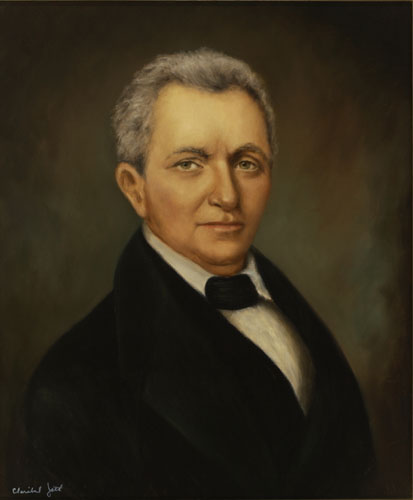<Back to Index>
- 1st Territorial Governor of Florida William Pope Duval, 1784
- Treaty of Moultrie Creek, 1823
PAGE SPONSOR

William Pope Duval (September 4, 1784 – March 19, 1854) was the first civilian governor of Florida Territory, serving from April 17, 1822 until April 24, 1834.
William Duval was born to Major William Duval and Ann Pope in "Mansfield," Henrico Co., Virginia (near present day Richmond). At the age of 14, he left home and struck out on his own, settling in Bardstown, Kentucky. He began to study law and was admitted to the bar at 19 in 1804. On October 3, 1804, he married Nancy Hynes in Bardstown.
During an outbreak of Indian hostilities in 1812, Duval was given command of a company of mounted Volunteers. This service and his law experience helped to win him election to the 13th Congress of the United States in 1812. He served as a representative from the Democratic - Republican Party in the new Kentucky's 10th congressional district until 1815 when he did not seek re-election. He returned to Kentucky and continued to practice law.
In 1821, Florida became a U.S. Territory, Duval was named United States Judge for the East Florida district on May 18, 1821. On April 17, 1822, President James Monroe appointed him as the first non - military governor of the territory, succeeding General Andrew Jackson. He was reappointed by President John Quincy Adams and President Andrew Jackson. During his twelve year administration, he established the territory’s capital at Tallahassee. He was also known for his peaceful dealings with the Native Americans living in the state. He signed the first act of legislation in Florida as a U.S. Territory, dividing it into four territories and establishing the local court system.
Duval continued to live in Florida for a number of years, practicing law. He moved to Texas in 1848. He and his wife had eight children, many of which began families in Texas, most notably Burr Harrison Duval. He died in Washington, D.C. He is interred at the Congressional Cemetery.
- Duval County, Florida, is named for him.
- Duval County, Texas, is named for his son, Capt. Burr Harrison Duval
There are many roads across Florida named after him, the most well known being Duval Street in Key West, Florida.
The Treaty of Moultrie Creek was an agreement signed in 1823 between the government of the United States and several chiefs of the Seminole Indians in the present day state of Florida. The United States had acquired Florida from Spain in 1821 by means of the Adams - Onís Treaty. In 1823 the government decided to settle the Seminoles on a reservation in the central part of the territory. A meeting to negotiate a treaty was scheduled for early September 1823 at Moultrie Creek, south of St. Augustine. About 425 Seminoles attended the meeting, choosing Neamathla, a prominent Mikasuki chief, to be their chief representative. Under the terms of the treaty negotiated there, the Seminoles were forced to place themselves under the protection of the United States and to give up all claim to lands in Florida, in exchange for a reservation of about four million acres (16,000 km²).
The reservation would run down the middle of the Florida peninsula from just north of present day Ocala to a line even with the southern end of Tampa Bay. The boundaries were well inland from both coasts, to prevent contact with traders from Cuba and the Bahamas. Neamathla and five other chiefs, however, were allowed to keep their villages along the Apalachicola River.
Under the Treaty of Moultrie Creek, the United States government was obligated to protect the Seminoles as long as they remained peaceful and law abiding. The government was supposed to distribute farm implements, cattle and hogs to the Seminoles, compensate them for travel and losses involved in relocating to the reservation, and provide rations for a year, until the Seminoles could plant and harvest new crops. The government was also supposed to pay the tribe US$ 5,000 a year for twenty years, and provide an interpreter, a school and a blacksmith for the same twenty years. In turn, the Seminoles had to allow roads to be built across the reservation and had to apprehend any runaway slaves or other fugitives and return them to United States jurisdiction.